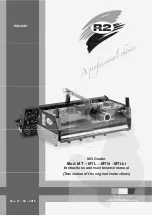
MSRD28 Rev B
081723
7
7227CLE (20’)
7229CLE (25’)
7232CLE (30’)
Longest Arrest Distance
134” (3.4 m)
96” (2.4 m)
Largest Average Arrest Force
1,003 lbs (4.5 kN)
919 lbs (4.1 kN)
Largest Maximum Arrest Force
1,649 lbs (7.3 kN)
1,427 lbs (6.3 kN)
5’ (1.5 m) Setback
0’ Setback
4.5
Personal Fall Arrest System:
A PFAS is an assembly of components and subsystems used to arrest a person during a fall event. A PFAS
is typically composed of an anchorage and a FBH, with an energy absorbing connecting device, i.e., an SAL, an SRD, or a Fall Arrester
Connecting Subsystem (FACSS), connected to the dorsal D-ring of the FBH. PFAS components used in conjunction with this SRD should
comply with ANSI Z359 and applicable OSHA regulations.
4.6
Average Arrest Force and Arrest Distance:
Table 1B provides test data on typical performance attributes of the three principal
parameters, Arrest Distance, Average Arrest Force and Maximum Arrest Force, listed by model number and class. Testing is conducted
under various environmental conditions; at ambient temperature, plus hot, cold, and in wet conditions. In manufacturer’s tests, worst
case performance attributes of the SRD, connected at foot-level (maximum of 5 feet below the dorsal D-ring) in a Leading Edge application
with 5’ (1.5m) of setback, or with 0’ setback, are:
A
Never connect two active components (snap hooks or carabiners) to each other.
B
Never connect two active components (snap hooks or carabiners) to a single D-ring at the same time.
C
Never connect in a way that would produce a condition of loading on the gate.
D
Never attach to a object in a manner whereby the gate (of the snap hook or carabiner) would be
prevented from fully closing and locking. Always guard against false connections by visually inspecting for closure and lock.
E
Never attach explicitly to a constituent subcomponent (webbing, cable or rope) unless specifically provided for by the manufacturer’s instructions for both
subcomponents (snap hook or carabiner and webbing, cable or rope).
F
Never attach in a manner where an element of the connector (gate or release lever) may become caught on the anchor thereby producing additional risk of
false engagement.
G
Never attach a spreader snap hook to two side/positioning D-rings in a manner whereby the D-rings will engage the gates; the gates on a spreader must
always be facing away from the D-rings during work positioning.
Figure 3 - Non-Compatible Connections
7268CLE (50’)
7265CLE (60’)
Longest Arrest Distance
127” (3.2 m)
125” (3.2 m)
Largest Average Arrest Force
1,004 lbs (4.5 kN)
944 lbs (4.1 kN)
Largest Maximum Arrest Force
1,608 lbs (7.2 kN)
1,792 lbs (8.0 kN)
The Competent Person may find this data useful with planning anchorage location and calculating fall arrest loads and distances from the
walking/working level to the nearest obstruction or lower level. See Section 5.
NOTE:
Arrest distance is one part of the Minimum Required Fall Clearance (MRFC). The MRFC is determined by consideration of multiple
factors in fall protection. Attachment below the level of the FBH D-ring will require additional fall clearance. MRFC is discussed in
detail in Section 5.
5’ (1.5 m) Setback
0’ Setback







































